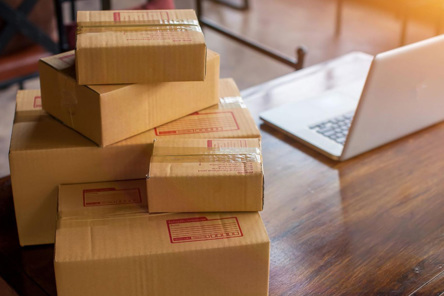Returns are no longer a back-office afterthought, but rather they are a defining element of the ecommerce customer experience. For online shoppers, a smooth, transparent return process can make or break brand loyalty. For retailers, reverse logistics has evolved from a necessary cost to a strategic lever for retention, efficiency, and differentiation.
As return rates in ecommerce continue to climb, especially in categories like apparel, electronics, and home goods, brands are looking for ways to simplify and scale their ecommerce returns management. That’s where smart reverse logistics comes in. With the right technology, processes, and partnerships in place, online retailers can turn returns from a pain point into a competitive advantage.
The Hidden Complexity of Returns for Online Stores
Managing reverse logistics for online stores is more challenging than it may seem. Unlike outbound shipping, where products move predictably from warehouse to customer, returns are initiated at random, vary widely in condition, and often follow fragmented processes.
Common challenges include:
-
Lack of consistency across sales channels or marketplaces
-
Manual return processing and limited visibility
-
Delays in refunds that frustrate customers
-
Rising transportation and restocking costs
-
Poor data on why items are being returned
As ecommerce scales, these problems multiply. Without a smart, connected approach to reverse logistics, brands risk eroding customer trust and losing margin.
What a Customer-Friendly Return Process Looks Like
Returns are inevitable. But a customer-friendly return process can make all the difference in whether a shopper decides to buy from your brand again. Here’s what a seamless return experience should include:
Frictionless Initiation
The return process should start online, with no need to call customer service or dig through paperwork. An ideal system includes:
-
Easy-to-use return portals with automatic order lookup
-
Self-serve label printing or the option to use QR codes at drop-off locations
-
Clear return policies, deadlines, and refund expectations
Reducing friction here not only improves customer satisfaction but also minimizes abandoned returns and support tickets.
Fast Refunds and Real-Time Updates
Today’s customers expect instant gratification, and that extends to returns. Brands that offer:
-
Instant or near-instant refunds once a return is scanned
-
Real-time status updates via SMS or email
-
Digital receipts and tracking visibility
create a sense of transparency and trust. This helps reinforce brand reliability, even when a purchase didn’t work out.
Flexible Drop-Off and Pickup Options
Convenience is king in ecommerce. Customers appreciate having multiple options to return a product, including:
-
Local drop-off at lockers, shipping centers, or partner retailers
-
At-home pickup scheduling for bulky items
-
Aggregated drop-off for multi-item returns
Giving customers choices in how they return products increases follow-through and reduces friction.
Smart Returns Solutions That Benefit Retailers
Customer satisfaction is only part of the story. Smart returns solutions must also support the retailer’s bottom line. Logistics partners like SEKO bring powerful tools to the table to help retailers process returns more efficiently and cost-effectively.
These include:
-
Centralized return hubs for consolidation, inspection, and sorting
-
Automated disposition recommendations to guide repair, resale, or recycle
-
Label-free and box-free return programs to cut shipping waste and material costs
-
Real-time data dashboards to track return volumes, SKUs, conditions, and reasons
Retailers that invest in these capabilities gain better control over inventory, reduce costs associated with restocking and repackaging, and gain insights that can improve upstream decisions like product design or sizing guides.
SEKO’s Approach to Return Optimization for Ecommerce
SEKO Logistics partners with leading ecommerce brands to make reverse logistics smarter, faster, and easier, for both customers and internal operations teams. Our approach to return optimization for ecommerce is built around flexibility, automation, and visibility.
Key capabilities include:
-
Branded return portals customized for each client’s workflows
-
QR-code-based returns that eliminate the need for printed labels
-
National and international drop-off networks for customer convenience
-
Consolidation and sorting at strategically located hubs
-
Automated triggers for refunds and status updates
SEKO’s reverse logistics model is designed to reduce touchpoints, lower transportation costs, and minimize waste, while keeping the customer experience seamless and transparent.
Whether a brand is operating through direct-to-consumer, marketplace, or hybrid ecommerce models, SEKO ensures that every return is managed with precision, accountability, and speed.
Redefining Returns as a Growth Lever
Returns are often seen as a cost to be managed. But forward-thinking ecommerce brands see them as an opportunity. A smart, customer-friendly return experience boosts brand perception, improves retention, and reduces negative reviews.
With ecommerce returns management built on visibility, technology, and agility, brands can:
-
Convert more one-time buyers into loyal customers
-
Improve operational efficiency and profitability
-
Unlock valuable insights about products, customers, and fulfillment
Let SEKO Streamline Your Ecommerce Returns
SEKO Logistics is a proven reverse logistics partner for ecommerce brands looking to modernize their returns strategy. With a flexible platform, global infrastructure, and deep experience in retail and consumer goods, SEKO delivers returns that work for both your customers and your business.
If you are ready to simplify returns and build a smarter reverse logistics strategy, connect with SEKO to learn how our smart returns solutions can transform your post-purchase experience.



